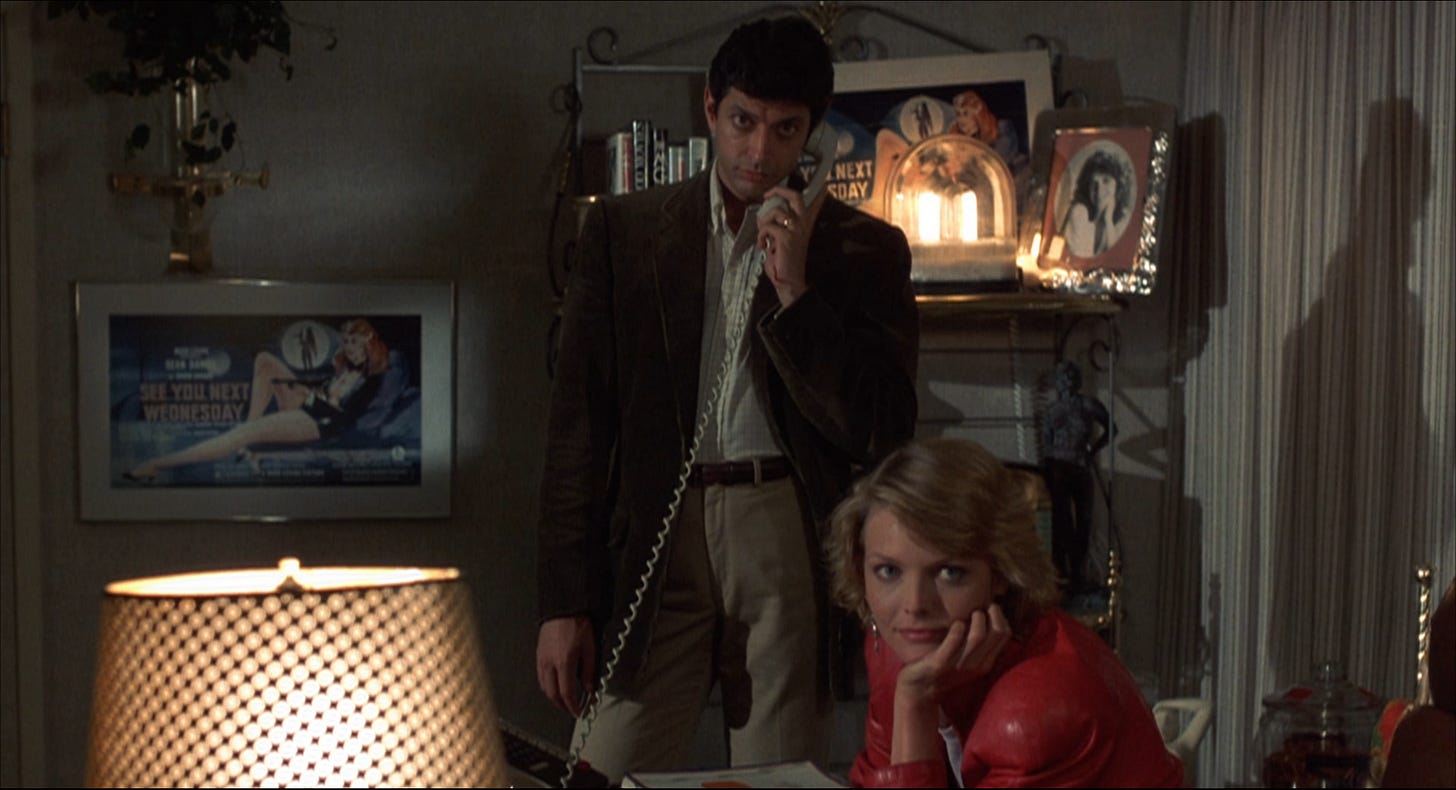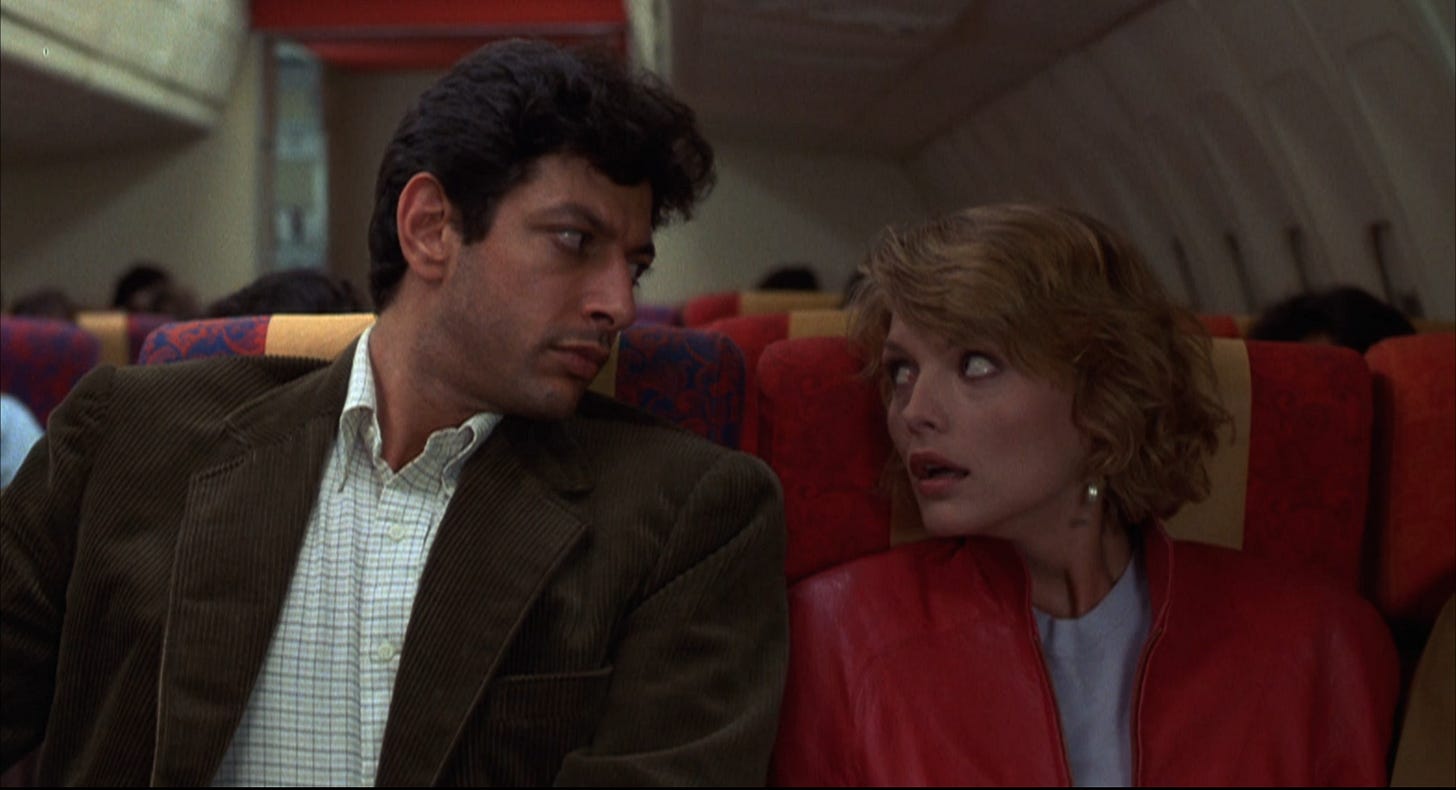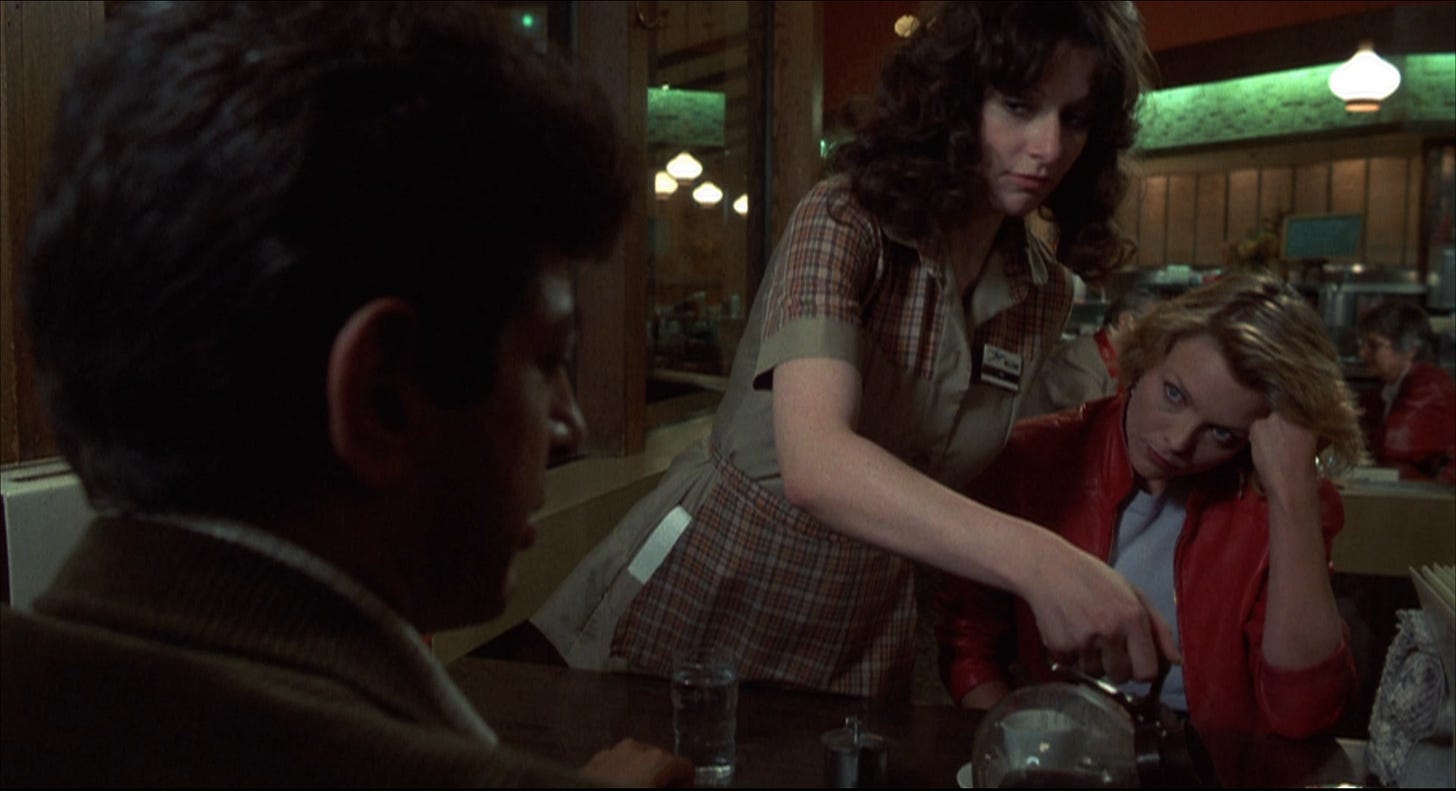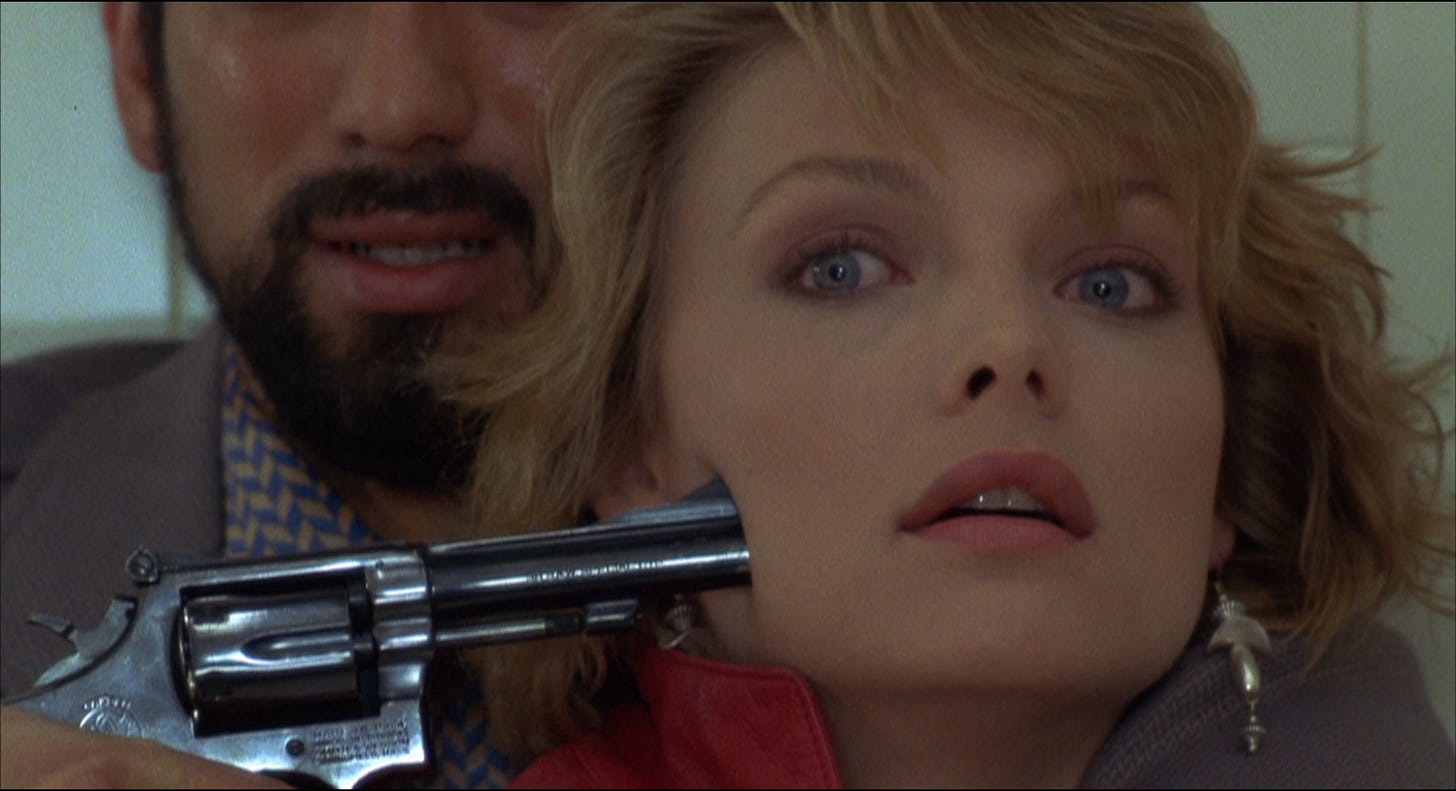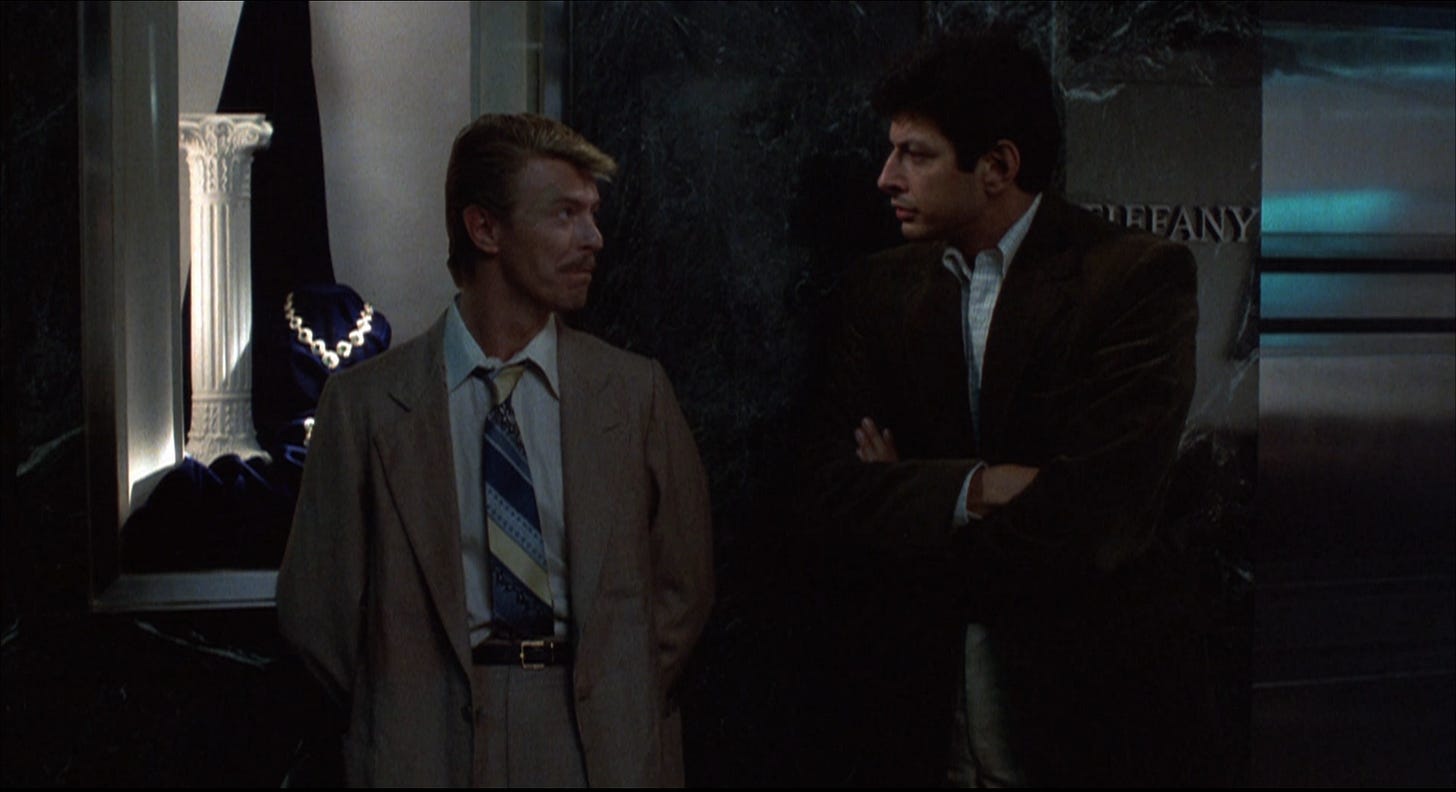Video Days is Mad About Michelle in the month of April, with ten films starring leading lady Michelle Pfeiffer, born April 29, 1958 in Santa Ana, California and celebrating her 67th birthday this month.
INTO THE NIGHT (1985) gets in the ballpark of an excellent neo-noir or romantic thriller. It has too many flaws to qualify as an excellent neo-noir or romantic thriller, but being on the field with a film like After Hours (1985) as opposed to standing right next to one that’s competent but forgettable qualifies as a win. Its male and female leads are wonderfully cast–a bit of black magic from the filmmakers anticipating superstardom for both–and the film is ably assisted by terrific music, as well just enough catty-corner weirdness to stick.
Before he created the TV series Beauty and the Beast in 1987, Ron Koslow was a working screenwriter with several credits under his belt. He’d authored a feature–Lifeguard (1979) starring Sam Elliott, Anne Archer and Kathleen Quinlan–and on commission, the prime time TV movies Lady of the House (1978) with Dyan Cannon as California madam Sally Stanford, and a shared writing credit with Michael Mann on Swan Song (1980) which starred David Soul as a champion skier. In 1981, a romantic thriller Koslow had written on spec titled Into the Night started making the rounds. It was set over two days in L.A., mostly after hours. Producer George Folsey Jr. passed the script to his filmmaking partner John Landis to see if it might be anything Landis would be interested in directing. Landis saw what he thought were interesting possibilities in Koslow’s script, which focused on an aerospace engineer who, suffering from insomnia, spends the story in a state of exhaustion. He also liked the femme fatale, who maintained a degree of gentleness to go along with her desperation.
To find a leading man, Landis started at the top and sent the script to Jack Nicholson, then at his second career peak, nominated for and soon to win an Academy Award for Best Supporting Actor in Terms of Endearment (1983). As Landis remembers it, Nicholson summoned him to Aspen in the dead of winter to tell the director he was turning the role down. In Nicholson’s view, the guy, Ed Okin, went through the picture without solving his problem. Folsey/ Landis, who’d set Into the Night up at Universal Pictures, the studio where Folsey had produced and Landis directed National Lampoon’s Animal House (1978), The Blues Brothers (1980) and An American Werewolf In London (1981), got a commitment from Gene Hackman to play the part, but Frank Price, then chairman of Universal, immediately vetoed this. Price was coming off a successful run as CEO of Columbia Pictures, and one of his regime’s hits had been The Big Chill (1983). Price suggested one of its ensemble players for the lead: Tom Berenger. The actor was unavailable. As a runner-up, Kevin Kline’s name was suggested, but he wasn’t free either.
Watching The Big Chill again, Landis noticed Jeff Goldblum, charming as what should’ve been an insufferable celebrity journalist. Goldblum had never been cast as a leading man, but recalibrated Okin as a man having a quarter life rather than a midlife crisis. To play the dame he gets mixed up with, Landis gave the part to Jamie Lee Curtis, who Landis had directed in her breakout role in Trading Places (1983). Having been chased through the night on film by her share of psychos, Curtis dropped out of Into the Night several weeks before shooting to take a job that was also far more financially lucrative, opposite John Travolta in Perfect (1985). Landis credited Ed Limato, the talent agent then with William Morris Agency who knew about Into the Night because he represented Tom Berenger, for lobbying his client Michelle Pfeiffer for the role. Landis was vaguely aware of Pfeiffer as the malnourished cocaine-addled gangster’s moll in Scarface (1983) and screening the picture again, didn’t believe she was at all who he was looking for. Meeting Pfeiffer and having her read changed the director’s mind.
Landis, alternating between star-driven entertainments with huge budgets, and smaller pictures with lesser known actors, went the latter route with Into the Night, an $8 million production. Shooting commenced in April 1984 in Los Angeles. Most of the more familiar L.A. landmarks were used as locations. Los Angeles International Airport, Marina Del Rey, Hollywood, Rodeo Drive in Beverly Hills, the Beverly Wilshire Hotel, the Century Towers in Century City, Malibu. Landis landed David Bowie and Dan Aykroyd in small roles and in what perhaps started as an opportunity to work with his friends, a sizable number of film directors in cameos. The film’s third star was the music of B.B. King. In addition to performing three songs–”Into the Night, “My Lucille,” “In the Midnight Hour” arranged by the film’s music composer Ira Newborn–the artist watched the picture twice and on this third sitting, laid down a guitar track where he felt appropriate. King’s guitar riffs were woven into the soundtrack by Newborn.
Following a limited release in New York and Los Angeles in February 1985, Into the Night opened in 1,096 theaters in the U.S. the following month. With few exceptions, reviews were scathing. Gene Siskel and Roger Ebert turned two thumbs down. Siskel summed the movie up as a chase picture in which we don’t give a hoot what happens, while Ebert deplored the waste of two interesting characters in a standard thriller. Kevin Thomas, the B-critic for the Los Angeles Times, loved the picture, and in his positive review, Richard Corliss of Time magazine was later credited for inventing the term “drop-dead gorgeous” in print to describe Michelle Pfeiffer in Into the Night. The small scale romantic thriller was ignored by American audiences (according to Landis, it played much better in Europe). Cable television and a home video market that was taking off earned Into the Night fans, particularly as a movie watched late at night in the zombie hour its zaniness is taking place.
Into the Night starts squandering a trunk full of exciting and romantic possibilities with characters and situations that feel like they were assembled under duress, as if the filmmakers hadn’t slept and had a script to turn in at sunrise. Jeff Goldblum plays an aerospace engineer, one of only three characteristics in the script unique to Los Angeles that aren’t standard all over the world. His character might as well have operated a donut shop considering his mechanical skills never come into use. A freeway commute–the second L.A. centered feature of the film–with a coworker played by Dan Aykroyd is witless, utilizing none of Aykroyd’s gifts as a gearhead, or performance skills which could’ve been used to get under Goldblum’s skin. Anyone who’s tried to operate without sleep will note how little Ron Koslow uses mental exhaustion in his script. Goldblum certainly gives an aloof performance in what would be many formal Goldblum performances. He’s compelling to watch, never taking the turn we quite expect a leading man to take. Then Michelle Pfeiffer enters. Pfeiffer not only has the best character in the film, but one of the best of her career, a model whose acting career didn’t pan out, and as the kept woman of a wealthy man (Richard Farnsworth) has nothing and nowhere to go when his sponsorship ends. She unwittingly becomes a courier of stolen goods, but rather than deviousness, is more perplexed about how she ended up in this spot. That’s the third characteristic of Into the Night uniquely suited to Los Angeles.
David Bowie appears in two scenes as a charmingly seedy hoodlum. Standing next to Goldblum, it’s hard to know which man is more attractive and who deserves more of our attention. Inexplicably, Landis subs out Goldblum, Bowie and Pfeiffer to bring in four trigger-happy Persian hoods, an Elvis impersonator (Bruce McGill), a bodyguard (celebrity fitness trainer Jake Steinfield), a director/ actor couple played by director Paul Mazursky and actor Kathryn Harrold, more Persians standing around, and Vera Miles glaring over Farnsworth in one scene as his wife. Then there are moments when the camera lingers on oddly placed extras who have no relation to the plot and we never see again. These are directors Landis called on to cameo: Jack Arnold, David Cronenberg, Amy Heckerling, Paul Bartel, Jim Henson, Lawrence Kasdan, Jonathan Demme. It’s possible that after criminal indictments were handed down to Landis and Folsey for involuntary manslaughter in the deaths of actor Vic Morrow and two children on the set of Twilight Zone: The Movie (1983), the director wanted to surround himself with supporters instead of workers. The energy Landis expends plugging directors into throwaway roles is misspent in what Nicholson recognized as the script’s central problem: Ed doesn’t address what’s keeping him awake. Jeff Goldblum and Michelle Pfeiffer–billed over the title for the first time in their careers–rescue Into the Night single-handed. It’s not accurate to say their chemistry is great. With his jazz musician’s playfulness, any woman would have chemistry with Goldblum, while Pfeiffer establishes herself as a leading lady with a hard comic edge. In what comes off as a sloppily written and indulgently made picture, they’re nothing short of transcendent.
Video rental category: Mystery/ Suspense
Special interest: On the Run


